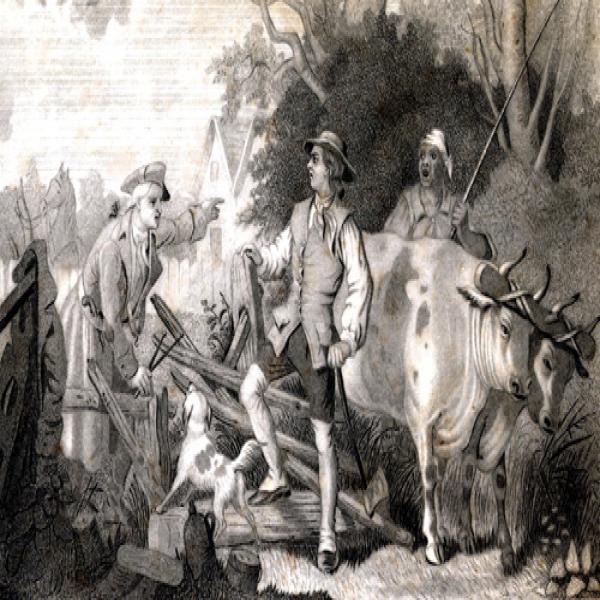Putnam receiving the news of the Battle of Lexington
Original

Background Notes
Israel Putnam (1718-1790) was born in Salem Village, MA to Joseph Putnam and Elizabeth Porter. He was not interested in education but loved being physically active and adventurous and had a reputation for courage and competitiveness as a young man. A year after marrying Hannah Pope in 1739, they would together move to undeveloped Pomfret, in the Northeast corner of Connecticut. After mothering ten children, Hannah died in 1765, after which Putnam married Deborah Lothrop Gardner. If it weren't for opportune circumstances (the French and Indian War) he would of passed into obscurity, but instead his ambitious personality led him to the greatness he later achieved as a war hero.
During the French and Indian War, Putnam excelled in guerilla tactics, fighting with the Connecticut militia in special unit known as Roger's Rangers. He quickly proved his talents as a skilled warrior and was promoted to captain in 1755 and then to major in 1758. At the conclusion of the French and Indian War, he returned to his life as a successful farmer, but his leadership was again summoned in 1764 during Pontiac's Rebellion when he was appointed Commander of five militia battalions. Putnam helped organize the Conn. Chapter of the Sons of Liberty, and was elected chairman of its committee of correspondence. From 1766-67 Putnam served as a deputy representing Pomfret in the Connecticut General Assembly, and headed west to explore the Mississippi river on behalf of a group of land speculators between December 1772 and August 1773. After the battle of Lexington in April 1775, he was appointed brigadier general, the third-highest ranking officer in the Connecticut Militia. Putnam's superb performance in a series of minor skirmishes earned him an ascension to the notable rank of major general in the Continental Army. It was he who offered his command of the field to Gen. Joseph Warren, who graciously refused and fought as a common soldier. Although Warren was slain in that engagement, Putnam's display of effort was exemplary.
Less exemplary, however, was his performance in the Aug. 1776 Battle of Long Island, where he allowed, under his command, the left flank of the Continental Army to become entrapped between British forces, resulting in a staggering number of American casualties. In the defense of Philadelphia in the winter of 1776-77, he fought humbly right alongside his troops and was particularly revered by his men. His hearty, gregarious nature was a contrast to George Washington's reserved, noble demeanor, yet the two men greatly respected each other. Washington's trust in his junior partner's abilities as a military strategist began to wane with his personal observation of Putnam's tactical skills, and the latter was replaced in 1778 by Major General Alexander McDougall (1732-1786). Washington reluctantly reassigned Putnam soon after to his former position, replacing Maj. Gen. Charles Lee (1731-1782) at White Plains, NY. His men saw little action during this time, and his military career ended with a stroke he suffered in Dec. 1779. He later recuperated and operated a tavern in his hometown of Pomfret, Connecticut where he became a fabled storyteller in his last days.
This image from the mid-nineteenth century is based upon a rumor developed during the revolutionary war that Putnam rushed to the defense of colonial forces in the Boston area, leading his Connecticut reinforcements to Cambridge, as soon as he received word that blood had been shed at Lexington. He reportedly was in such haste that he left his team of mules unhitched upon his exit, as he was in the middle of plowing for spring planting. (1)
The engraver of this image is Adam B. Walter (1820-1875). Born in Philadelphia. He was an excellent engraver of portraits, chiefly executed in mezzotint. (2)
1. American National Biography. S.V. .Israel Putnam.. (NY: Oxford 1999) p. 11-12
2. American Engravers upon Copper and Steel, (NY: Grolier Club, 1907) p. 284